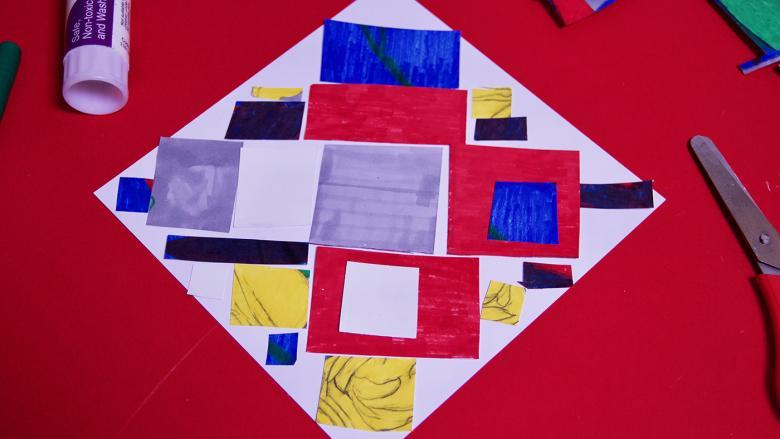
Follow this step-by-step activity to create a Mondrian-inspired picture.
Dutch painter Piet Mondrian (1872–1944) was inspired by views of the world around him. He is best known for his abstract paintings made up of geometric shapes, horizontal and vertical lines, primary colours (red, yellow, blue), as well as black, white and grey.
For this activity, you're going to look closely at an object and create your own Mondrian-inspired picture of it using geometric shapes and strong primary colours.
Let's get started!
Because of new e-privacy measures on our site, you'll need to click on the cookie symbol in the bottom-left corner of this page and tick the boxes to accept statistics and marketing cookies in order to watch this video. Or, scroll down to read the instructions instead!
Watch the video
Materials and instructions
Materials:
- A5 paper
- Square paper
- A pencil
- Markers, colouring pencils or crayons
- A rubber
- Ruler
- Scissors
- Glue
- An object (or objects) to draw (we chose to draw a rose in a vase)
You can also use a wearable viewfinder, if you like. You can find out how to make a viewfinder here. But, it's just an optional extra - you can still do the activity without it!
Instructions:
- Divide your A5 sheet of paper into a grid by drawing two vertical lines and two horizontal lines on it.
- Now, put on your wearable viewfinder (if you're using one) and look through it at your object. Or, simply make a frame shape with your index fingers and thumbs, and look through it at your object.
- Start drawing the object, using the grid to help you place it and the space around it.
- When you are happy with your drawing, rub out the grid lines. You might have to fix some of your drawing lines.
- Now you're ready to start colouring in! Mondrian used primary colours - yellow, blue and red - as well as black, white, and grey.
- When you're finished colouring, cut your drawing up into rectangles and squares - make them a mixture of different sizes.
- Take another look at how Mondrian arranged his shapes and spaces.
- Now, arrange your shapes on the big square piece of paper.
- Once you're happy with it, glue the shapes in place and enjoy your new abstract artwork!
Credits:
Devised by Elizabeth Archbold for the National Gallery of Ireland.
About our Gallery at Home videos:
Inspired by works in our collection and exhibitions, our creative activities encourage families to work together to create their own artworks. They are specially produced videos for babies, older children and for those who require sensory input. You can find all the workshops in this series here. Enjoy!
Explore more
-

National Gallery at Home: Wearable Viewfinder
Follow this step-by-step activity to create your own wearable vie
-

National Gallery at Home: A Colour Experiment!
Video: Try out this creative activity inspired by Turner's waterc
-

National Gallery at Home: Self-Portraits
Video: Draw a colourful self-portrait.
-

Resources for Schools \ Acmhainní do Scoileanna
Downloadable resources for students and teachers
